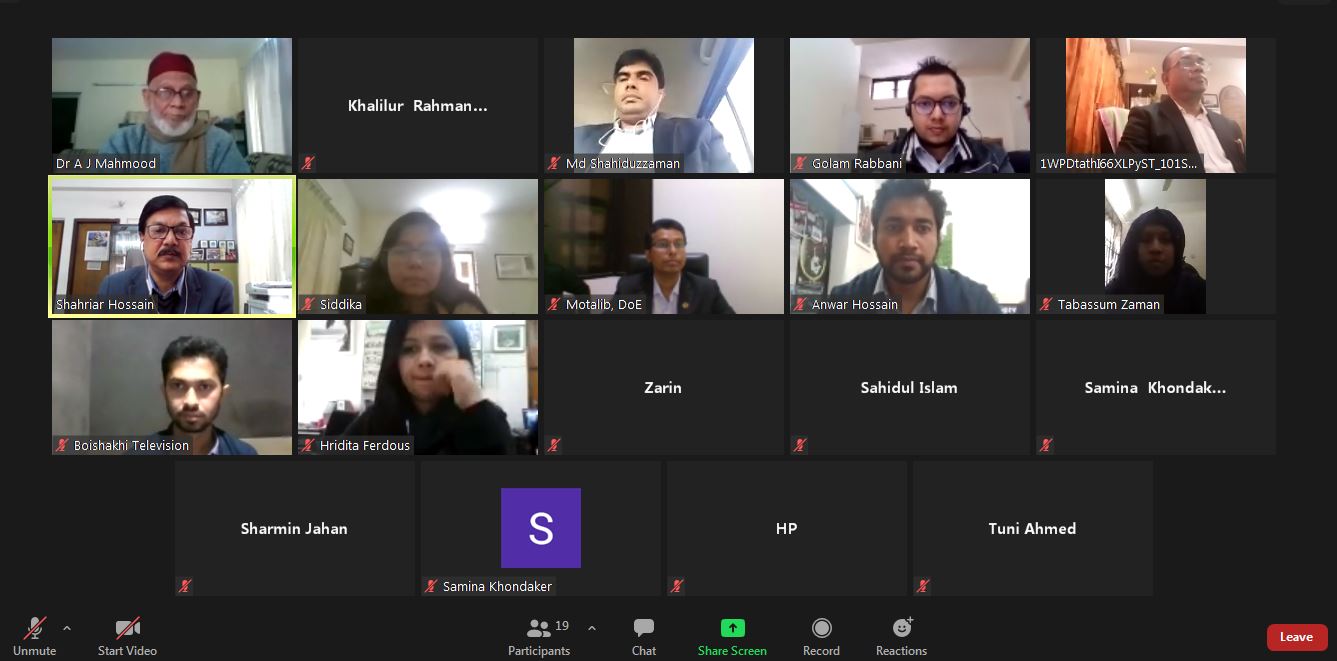Dhaka 4th Polluted City Globally

Dhaka, 28 December, 2020: According to ESDO recent study on air pollution in Bangladesh is translating the health loss to economic and ecological impacts. As per AQI value measured over past 11 months Bangladesh ranked 2 and Dhaka ranked 4 globally as most polluted city.
Environment and Social Development organization-ESDO disclosed the study on “Air Pollution in Bangladesh: Outdoor vs. Indoor: Sources and Penalties” on Monday in a press briefing through virtual platform Zoom. Experts said, air pollution and its impact is not just health issue, its created serious economic and ecological disaster, so solutions lie in multi-sectoral initiatives with common commitment to stop air pollution. This study a robust assessment of the trends and current situation in Bangladesh and numbering countries, and highlights that augmenting the existing air pollution control efforts based on the specific situation of each state would be useful.
Prof. Dr. Abu Jafar Mahmd, former Chairman of Department of Chemistry, University of Dhaka; Md. Ziaul Haque, Director (AQM), DoE (Department of Environment); Dr. Md. Shafiur Rahman, Assistant Professor, Department of Occupational and Environmental Health, NIPSOM, Dr. Shahriar Hossain, Secretary General, ESDO; Ms. Siddika Sultana, Executive Director, ESDO along with other ESDO team members attended the briefing and responded to the question of reports.
According to ESDO’s study on the indoor and outdoor air pollution in rural and urban area, most of the pollutants of outdoor pollution come from- construction activities(38%), open landfill incineration of plastic wastes(22%),industrial processes(17%), brick kilns(10%), combustion of fossil fuels for road transport and power generation (8%). However, the pollutants of indoor pollution come from- smoke emitted from cooking stove/burning of biomass (41%), smoke emitted from cigarette smoking (25%), gaseous substances emitted from toilet/sewerage (15%),radon gas and unseen indoor pollutants (10%), lead poisoning from decorative paint. (9%).
ESDO found an important factor that both seasonal variation and transboundary movement of air contribute much of the airborne pollutants which travel a long distance and cause unwanted air quality degradation. This is a major concern for a smaller country like Bangladesh, which is surrounded by highly polluted countries like India and Nepal. PM pollutants in South Asia throughout the dry, monsoon and winter season are probably transported towards Dhaka city through different routes. Northwesterly winds dominantly contribute to the PM pollutants during winter (November–January), whereas mixed wind directions are normally observed in pre-monsoon season (February–April). Depending upon the heights, air pollutants can travel from 200 to 500 km in a specified area. During winter, transboundary movement of the air pollutants is at its peak and entering into Bangladeshi region through Indian belt which is travelling from the northern side of the country (Rangpur, Dinajpur) and ended up in Dhaka, Mymensingh, Cumilla etc.
Estimation was that, by 2019, at least 200,000 people in Bangladesh would potentially embrace death due to respiratory diseases and longtime exposure to high concentration of polluted air. As air pollution exposure is linked with increased hospitalizations, disability, and early death from respiratory diseases, heart disease, stroke, lung cancer, and diabetes, as well as communicable diseases like pneumonia, the death rate increased sharply in recent years.
In the last five years (2015-2019), the number of asthma patients rose by a factor of 24 to 78,806 in 2019 from 3,326 in 2015. Deaths from the disease went up 10-fold to 588 from 56 in the same period. Similarly, the number of cases of chronic obstructive pulmonary disease (COPD) rose from 1,610 in 2015 to 78,806 in 2019, an increase by a factor of 49. Deaths from it increased 19-fold to 588 in the same period, according to a recent report of the health directorate.
By ESDO’s unceasing effort, this press briefing has been organized to uphold the current scenario of air pollution. Many reputed journalists from media platforms have participated and exchanged their views. Through this press briefing, general people will know the current status of air pollution in Bangladesh.


